The Boozy Difference Between French 75 And French 95 Cocktails
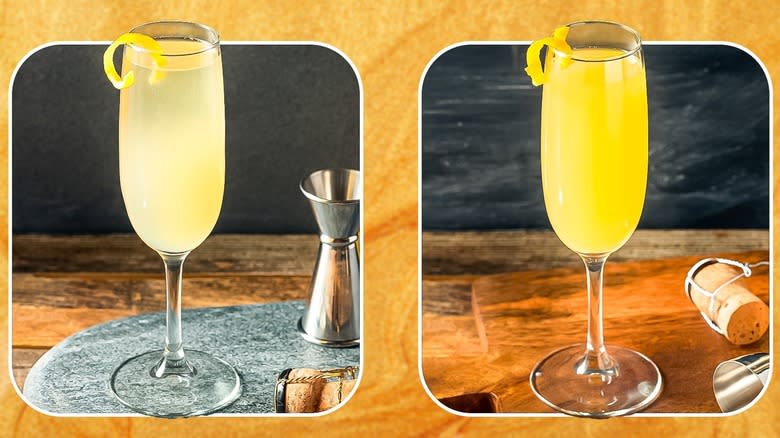
There's immense fun in riffing a cocktail. Simply swap one or two components, and a completely new drink emerges. While such a methodology can be applied to any ingredient, the effects are especially noticeable with the base spirit. Even making a transformation in the same style pays off in a completely different flavor. So, you can imagine what the effects would be if you changed the booze base altogether.
That's precisely the move in the French 95, which replaces the French 75's classic gin or Cognac base with bourbon. The bubbly, sour cocktail made with lemon juice, Champagne, and simple syrup takes on a completely new character. Yet, it still delivers a vibrant dose of flavor -- a quality honored in its artillery-referenced name.
The French 75-millimeter artillery gun was fired frequently during World War 1, and, in accordance with nomenclature, upgrading to a 95 only increases the drink's boozy firepower. But how else does that translate into the resultant cocktail? Let's take a closer look at what makes these two rifle-inspired cocktails different.
Read more: The 25 Best Bourbon Brands, Ranked
What Is A French 75?
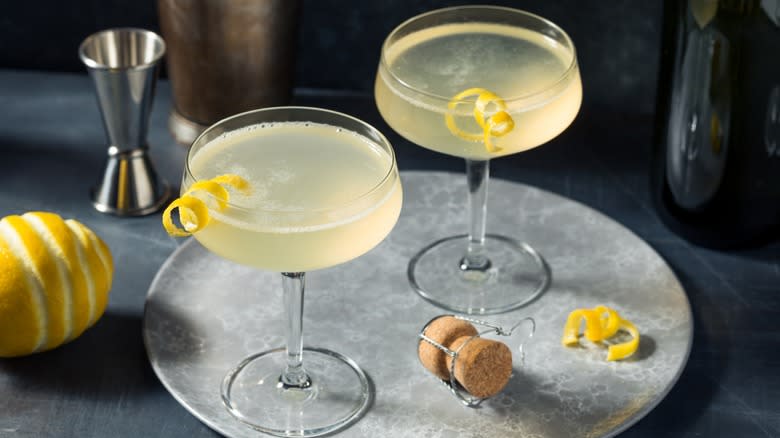
The effervescent French 75 offers up a sour drink with a Champagne twist. There are variations in spirit base; a gin-based cocktail emerged first, although many modern bartenders also craft it with Cognac. The sling's earliest version, dating to around 1915, combined grenadine, applejack brandy, gin, and lemon. However, 12 years later, a publication of the drink's recipe with Champagne altered the go-to formula, as well as coined its name.
The beverage is a type of sour, balancing simple syrup or sugar, lemon juice, and the base booze, before topping it all off with Champagne for a carbonated body and garnishing it with a twist of lemon peel. Especially due to the resultant mouthfeel, there is much discussion over the best type of cocktail glass to serve a French 75 in. In recent decades, a flute has become the go-to, in keeping with the drink's celebratory nature.
Plus, in most modern recipes, the Champagne represents the bulk of the drink's volume. Nevertheless, some claim that the Collins glass is the traditional choice, while others may also choose to serve it in a coupe. Regardless of how it's delivered, the French 75 offers a tantalizing mix of dryness, tang, and drinkability, all presented with a classy vibe.
What Is A French 95?
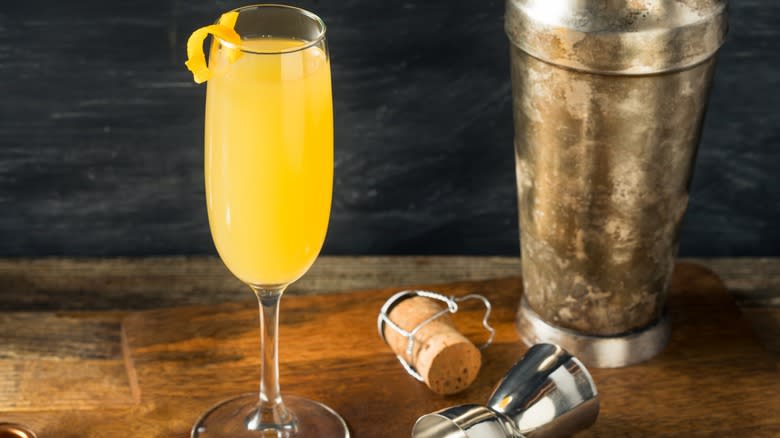
As evinced by the name, the French 95 builds off of a similar formula but swaps in bourbon for gin or Cognac as the alcohol base. The other components are identical. However, renditions often mix in more sugar, lending it a richer mouthfeel. Amplified by bourbon's boozier undertones, such a combination creates a cocktail with a more robust, spirit-forward flavor profile.
Unlike the early 20th-century origins of the French 75, this bourbon-inflected creation arose in the 1970s, alongside other versions with swapped-out booze. However, the bourbon rendition endured more than others, continuing in popularity through to the present day. Since the drink's palate heavily relies on the spirit, it's essential to purchase a high-quality bourbon.
And, as with the French 75, the quality of the Champagne used makes an impact, too, with drier varieties being preferable. Plus, due to the distinguishable flavor palate, the cocktail often receives a different garnish: a dehydrated orange slice or peel instead of a lemon twist. The fine-tuning of such components has resulted in a delicious drink with its own distinct identity.
A French 75 Offers A Lighter, More Spirit-Focused Cocktail
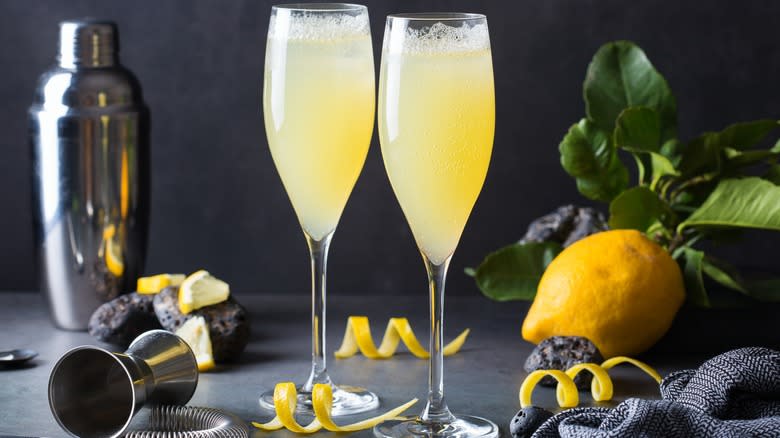
Due to the overlap of most components, it's no surprise that the two cocktails offer a similar experience. However, tweaks in the ratios and utilized spirit do make a difference in the resultant beverage. For starters, in the French 75, gin's herbal and aromatic palate is showcased, accentuated with half of the amount of sugar and lemon juice found in the French 95. Combined with the dry Champagne, this lends the drink a drier, more refreshing quality, as opposed to the French 95's boozy and bold nature.
Such a character is further reflected in the cocktail's appearance. The French 75 has a yellow-to-white color, much lighter in tint than the French 95. However, that's not to say that the French 75 is less flavorful. Gin is a more fragrant spirit, and varieties such as Hayman's London Dry Gin clock in with a slightly higher alcoholic content than bourbon, which all combine to create a flavorful yet effervescent concoction.
A French 95 Serves A More Bold And Boozy Take On The Drink
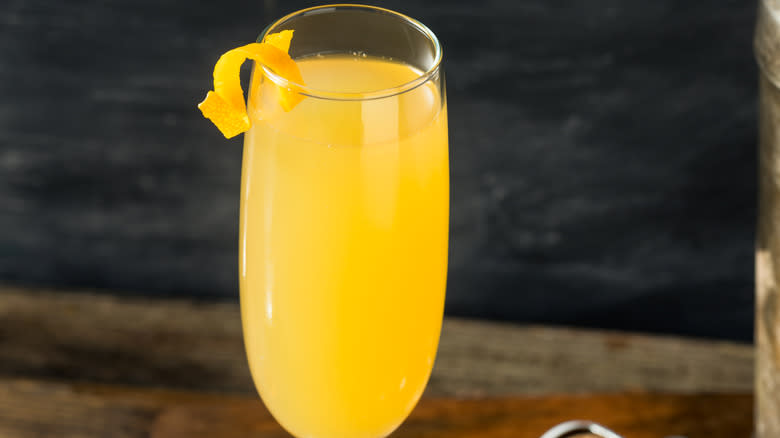
Bourbon's sweeter, slightly smoky, and spicier flavor offers a sharp contrast to a gin-based version of the drink. In order to smooth out its robust qualities, twice as much lemon juice and sugar are added to a mixed batch, brightening the spirit's darker tones into what's still a carbonated, refreshing drink. Such a quality is reflected in the drink's appearance. The French 95 has a reddish-pinkish or orangish tone, as opposed to the French 75's clear or yellowish-tinge.
Largely, such an effect is due to the barrel character. For whiskey (including bourbon), the wood barrel-aging process imparts a distinct color and key flavor characteristics like spice, caramel aromas, and other notes. This is showcased in the resultant French 95, creating a cocktail with a darker character as opposed to gin's bright and aromatic notes.
To maintain the refreshing nature of the build, opt for a mellower bourbon, like Woodford Reserve or Angel's Envy, or else the spirit may dominate over the dryness of the other ingredients. However, feel free to experiment -- new riffs showcase the malleable nature of drink components. So, don't be afraid to reach for a new bourbon, gin, or Cognac and sip and savor the results.
Read the original article on Tasting Table.

